If you have a flat tire
Remove the flat tire and replace it with the spare provided.
Before jacking up the vehicle
Stop the vehicle on a hard, flat surface.
Set the parking brake.
Shift the shift lever to P.
Vehicles with electronically modulated air suspension: Turn off the height control.
Stop the hybrid system.
Turn on the emergency flashers.
Location of the spare tire, jack and tools
- Vehicles with a compact spare tire.
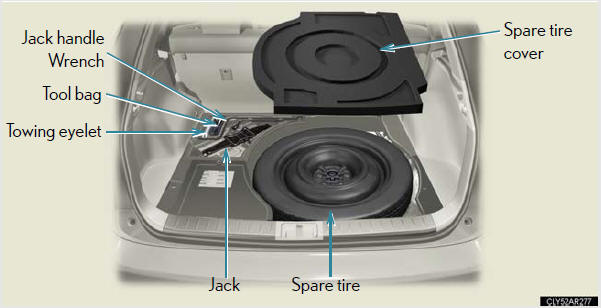
- Vehicles with a full-size spare tire
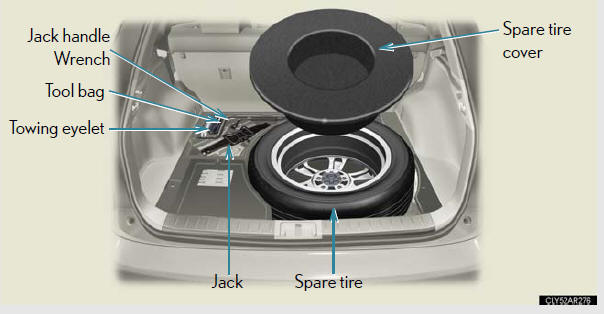
Taking out the jack
- Vehicles with a compact spare tire.
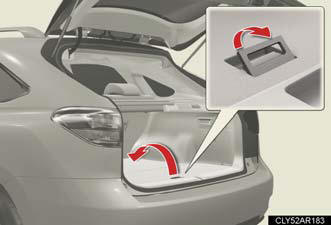
Pull the lever upward to fold back the front part of the deck board.
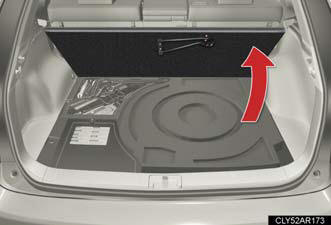
Pull the folded deck board upright.
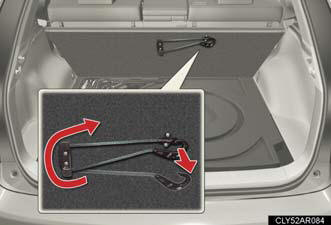
Pull on the attached hook to extend the string.
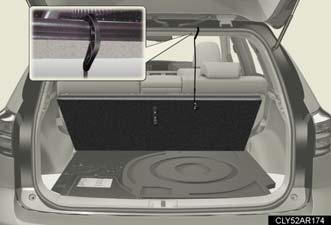
Use the hook to secure the deck board as shown in the illustration.
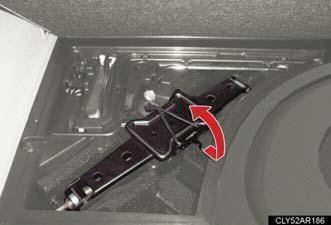
Remove the jack after removing the hook.
- Vehicles with a full-size spare tire.
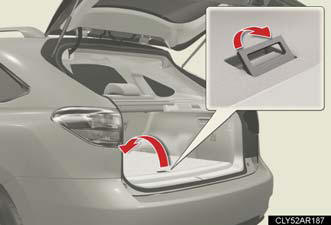
Pull the lever upward to fold back the front part of the deck board.
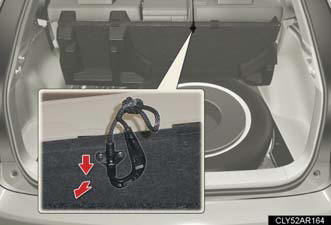
Pull on the attached hook to extend the string.
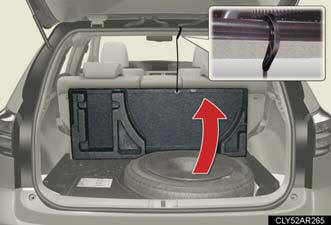
Use the hook to secure the deck board as shown in the illustration.
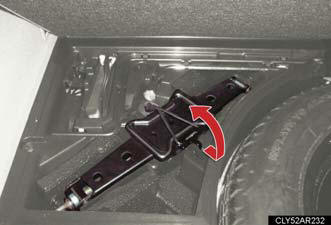
Remove the jack after removing the hook.
Taking out the spare tire
1. Lift up the deck board. (See “Taking out the jack” for details.).
Remove the spare tire cover.
2. Loosen the center fastener that secures the spare tire.
- Vehicles with a compact spare tire.
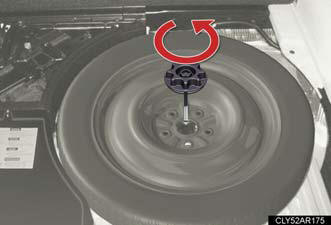
- Vehicles with a full-size spare tire.
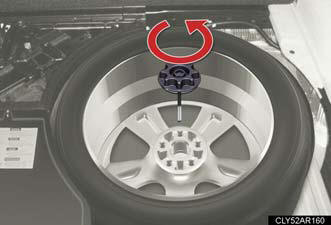
Replacing a flat tire
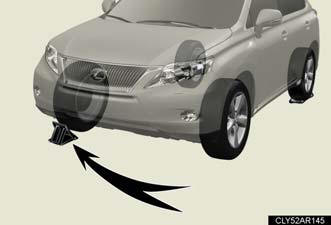
Chock the tires.
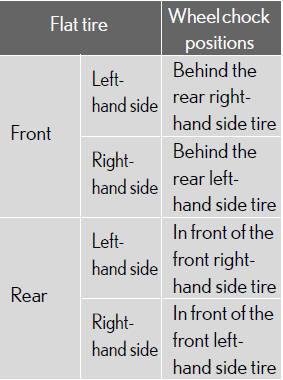
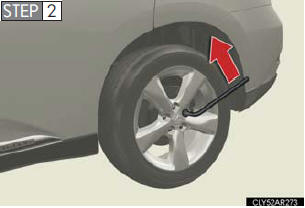
Slightly loosen the wheel nuts (one turn).
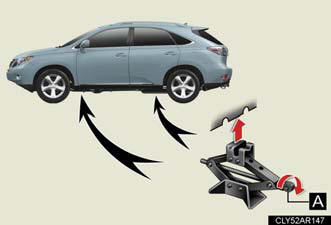
Turn the tire jack portion “A” by hand until the notch of the jack is in contact with the jack point.
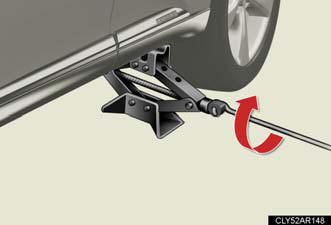
Raise the vehicle until the tire is slightly raised off the ground.
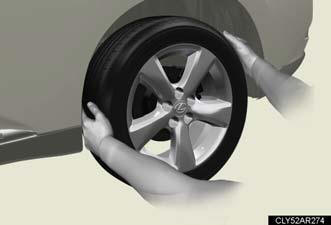
Remove all the wheel nuts and the tire.
When resting the tire on the ground, place the tire so that the wheel design faces up to avoid scratching the wheel surface.
Installing the spare tire
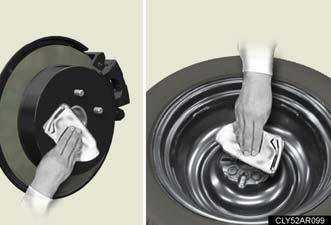
1. Remove any dirt or foreign matter from the wheel contact surface.
If foreign matter is on the wheel contact surface, the wheel nuts may loosen while the vehicle is in motion, causing the tire to come off.
2. Install the spare tire and loosely tighten each wheel nut by hand by approximately the same amount.
- Vehicles with a compact spare tire.
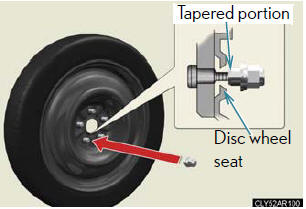
Tighten the nuts until the tapered portion comes into loose contact with the disc wheel seat.
- Vehicles with a full-size spare tire.
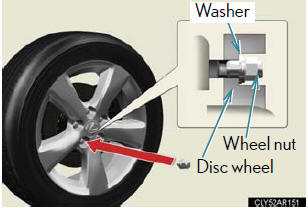
Turn the nuts until the washers come into contact with the wheel.
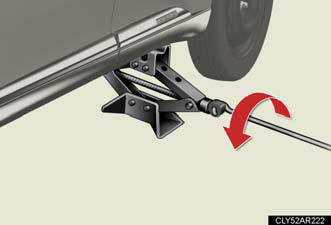
Lower the vehicle.
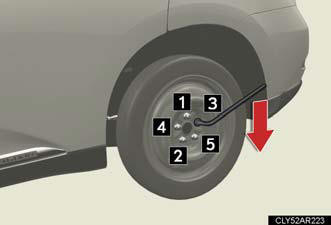
Firmly tighten each wheel nut two or three times in the order shown in the illustration.
Tightening torque:
76 ft•lbf (103 N•m, 10.5 kgf•m).
Stow the flat tire, tire jack and all tools.
The compact spare tire
The compact spare tire is identified by the label “TEMPORARY USE ONLY” on the tire sidewall.
Use the compact spare tire temporarily, and only in an emergency.
Make sure to check the tire inflation pressure of the compact spare tire.
When using the compact spare tire
As the compact spare tire is not equipped with a tire pressure warning valve
and
transmitter, low inflation pressure of the spare tire will not be indicated by
the tire
pressure warning system. Also, if you replace the compact spare tire after the
tire
pressure warning light comes on, the light remains on.
If you have a flat front tire on a road covered with snow or ice
Install the compact spare tire on one of the rear wheels of the vehicle.
Perform the
following steps and fit tire chains to the front tires:
1. Replace a rear tire with the compact spare tire.
2. Replace the flat front tire with the tire removed from the rear of the vehicle.
3. Fit tire chains to the front tires.
After completing the tire change
The tire pressure warning system (if equipped) must be reset.
CAUTION:
Using the tire jack
Improper use of the tire jack may cause the vehicle to suddenly fall off the
jack,
leading to death or serious injury.
Do not use the tire jack for any purpose other than replacing tires or
installing and
removing tire chains.
Only use the tire jack that comes with this vehicle for replacing a flat tire.
Do not use it on other vehicles, and do not use other tire jacks for replacing
tires
on this vehicle.
Always check that the tire jack is securely set to the jack point.
Do not put any part of your body under the vehicle while it is supported by
the
jack.
Do not start or run the hybrid system while your vehicle is supported by the jack.
Do not raise the vehicle while someone is inside.
When raising the vehicle, do not put an object on or under the jack.
Do not raise the vehicle to a height greater than that required to replace the tire.
Use a jack stand if it is necessary to get under the vehicle.
Vehicles with electronically modulated air suspension: Be sure to turn off the height control and stop the hybrid system.
Take particular care when lowering the vehicle to ensure that no one working on
or
near the vehicle may be injured.
CAUTION:
Replacing a flat tire
Observe the following precautions to reduce the risk of death or serious injury:
Do not touch the disc wheels or the area around the brakes immediately after
the
vehicle has been driven.
After the vehicle has been driven the disc wheels and the area around the brakes will be extremely hot. Touching these areas with hands, feet or other body parts while changing a tire, etc. may result in burns.
Never use oil or grease on the wheel bolts or wheel nuts.
Oil and grease may cause the wheel nuts to be excessively tightened, leading to
bolt or disc wheel damage. In addition, the oil or grease can cause the wheel
nuts
to loosen and the wheel may fall off, causing a serious accident. Remove any oil
or
grease from the wheel bolts or wheel nuts.
Have the wheel nuts tightened with a torque wrench to 76 ft•lbf (103 N•m, 10.5 kgf•m) as soon as possible after changing wheels.
Failure to follow these precautions could cause the wheel nuts to loosen and the tire to fall off, resulting in death or serious injury.
When installing a tire, only use wheel nuts that have been specifically
designed
for that wheel.
If there are any cracks or deformations in the bolt screws, nut threads or
bolt
holes of the wheel, have the vehicle inspected by your Lexus dealer.
Failure to follow these precautions could cause the wheel nuts to loosen and the
tire
to fall off, resulting in death or serious injury.
When using the compact spare tire Remember that the compact spare tire provided is specifically designed for use with your vehicle. Do not use your compact spare tire on another vehicle.
Do not use more than one compact spare tire simultaneously.
Replace the compact spare tire with a standard tire as soon as possible.
Avoid sudden acceleration, deceleration and braking, as well as sharp cornering.
CAUTION:
When the compact spare tire is attached
The vehicle speed may not be correctly detected, and the following systems may
not operate correctly:
ABS & Brake assist.
VSC.
TRAC.
VDIM.
Intuitive parking assist (if equipped).
Navigation system (if equipped).
Cruise control (if equipped).
Dynamic radar cruise control (if equipped).
Electronically modulated air suspension (if equipped).
Pre-Collision System (if equipped).
Also, not only can the following system not be utilized fully, but it may even
negatively
affect the drive-train components:
AWD system (if equipped).
Speed limit when using the compact spare tire
Do not drive at speeds in excess of 50 mph (80 km/h) when a compact spare tire
is
installed on the vehicle.
The compact spare tire is not designed for driving at high speeds. Failure to
observe
this precaution may lead to an accident causing death or serious injury.
NOTICE:
Do not drive the vehicle with a flat tire
Do not continue driving with a flat tire.
Driving even a short distance with a flat tire can damage the tire and the wheel beyond repair.
Be careful when driving over bumps with the compact spare tire installed on
the
vehicle.
The vehicle becomes lower when driving with the compact spare tire compared to when driving with standard tires. Be careful when driving over uneven road surfaces.
Driving with tire chains and the compact spare tire Do not fit tire chains to the compact spare tire.
Tire chains may damage the vehicle body and adversely affect driving performance.
When replacing the tires
When removing or fitting the wheels, tires or the tire pressure warning valve
and
transmitter, contact your Lexus dealer as the tire pressure warning valve and
transmitter
may be damaged if not handled correctly.
To avoid damage to the tire pressure warning valves and transmitters Do not use liquid sealants on flat tires.
See also:
What’s it up against?
Equipped with a V8 engine, the GS’ biggest traditional rivals come from
Germany – namely the BMW 550i and Mercedes-Benz E550. But can-do home-market
competitor Infiniti’s new M56 presents serious ...
Luxury/Comfort/Convenience
The standard Regency leather-trimmed, heated, 10-way power front seats
(perforated leather trim on Lexus GS 460) are comfortably contoured for support
on long trips. Ventilated front seats are sta ...
If the electronic key does not operate properly
If communication between the electronic key and vehicle is interrupted
or the electronic key cannot be used because the battery is
depleted, the smart access system with push-button start and wirele ...
